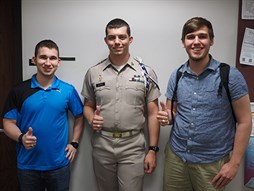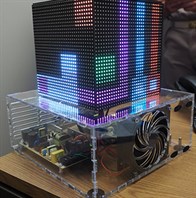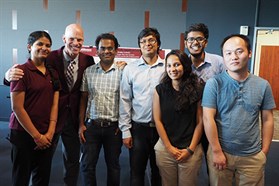Several students in the Department of Computer Science and Engineering at Texas A&M University are utilizing the skills learned in class to create unique and innovative projects being used in ways beyond the classroom.

Seniors Andrew Kirfman, Chris Martin and Michael Brand created the Improbability Cube, or as they also call it, Game³.
Initially, the group set out to create an LED display system that would visually display graphs and solutions to arbitrary calculus problems in order to assist first-year engineering students; this snowballed into a more technical plan to create an LED display system that would have gaming capabilities. With this start, they began to envision their project for Dr. Jyh-Charn Liu’s microcomputer systems course.
Using AutoCAD, Kirfman designed the box that all of the hardware resides in. All text displayed on the cube was drawn one pixel at a time, which understandably took a while to program.

The cube is a display created using five 32x32 LED panels. Images are written to it from a raspberry pi using a library that the team wrote in C++; each panel is on its own coordinate system.
“The greatest reward was being able to see the whole system in action at the end,” Kirfman said. “Everything in the entire project was done essentially from scratch. We had no direction, instructions, or hand holding throughout the project.”
Recently, Dr. Jeff Huang, assistant professor and Dr. Hank Walker, professor and graduate advisor, hosted a poster session for their CSCE 431 and CSCE 606 software engineering classes. This demonstration session was designed to provide students with the opportunity to design and develop free cloud-based software projects for the Bryan/College Station community.
 Fork Friendly was a web application designed by seniors Karrie Cheng, Brandon Arryo, Michael Barker, Kyle Wilson and Forrest Hicks, to help those with special dietary needs due to health conditions. The application allows the user to create a customized grocery list for their individual dietary restrictions.
Fork Friendly was a web application designed by seniors Karrie Cheng, Brandon Arryo, Michael Barker, Kyle Wilson and Forrest Hicks, to help those with special dietary needs due to health conditions. The application allows the user to create a customized grocery list for their individual dietary restrictions.
Bailey Bauman, Bob Timm, Jennings Fairchild, Lance Badoni, Mat Dyl and Nico Warner presented their project, “Care Coordinator.” The purpose of this tool is to allow a patient to coordinate their many health related activities and appointments with the various providers they are required to visit, optimizing the entire process. The team proposed this project to the Texas A&M Health Science Center with advisement by the Rural and Community Health Institute (RCHI). RCHI accepted the project and provided the additional requirements of high-level security, accountless-correspondence and export to PDF.
Another group’s project, “Cybersecurity Web Application,” was designed for the Texas A&M Cybersecurity Center and Director Dr. Daniel Ragsdale. The group was comprised of computer science graduate students, Avani Sama, Riu Liu and Sujoy Saha, and electrical engineering graduate students, Pravir Gupta, Sagar Samant and Swetha Sridharan. The students were tasked with developing a multi-field search and query function for the center’s website.

“For most of us it was our first software product so we had a very nice feeling of accomplishment,” Saha said.
Clients shared glowing reviews for the students’ effort and hard work.
One client said, "I am very pleased with the final product. It is exactly what I wanted and it is even better than I had hoped. I am truly grateful for the time and attention they gave to this project."
“Students work with real clients on building real-world software,” Huang said. “The final demo session is always my happiest time, not because it means the end of the semester, but because I see both the students and their clients are thrilled with their final product."